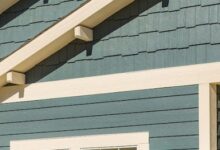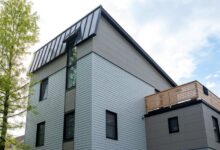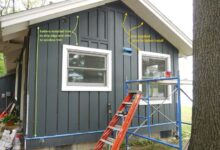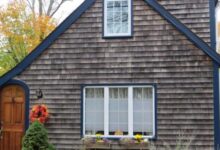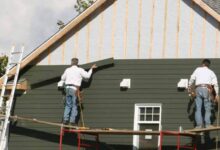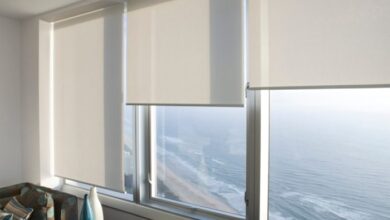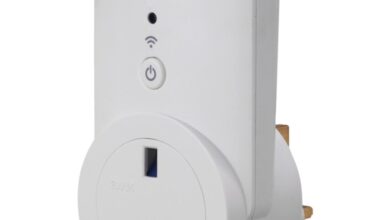Stone Veneer Siding A Comprehensive Guide
Stone veneer siding: the name conjures images of rustic charm, modern elegance, or perhaps a timeless classic. But beyond the aesthetics, lies a world of choices, from the type of stone and installation methods to long-term maintenance and cost considerations. This deep dive explores everything you need to know about stone veneer siding, helping you decide if it’s the right exterior cladding for your next project—or even a renovation.
We’ll unravel the complexities, revealing the secrets to successful installation, sustainable sourcing, and achieving the perfect aesthetic for your home.
From understanding the manufacturing process and exploring diverse stone types to comparing costs with other siding options, we’ll cover the essential aspects. We’ll equip you with practical advice, including step-by-step installation guides, maintenance tips, and troubleshooting solutions. Whether you’re a seasoned builder or a homeowner tackling a DIY project, this guide provides the knowledge and insights to make informed decisions about this versatile and enduring building material.
What is Stone Veneer Siding?
Stone veneer siding offers a beautiful, durable, and relatively cost-effective way to enhance the exterior of a home. It mimics the look of natural stone cladding but with a lighter weight and often a simpler installation process. This makes it a popular choice for both new construction and renovations, providing a high-end aesthetic without the hefty price tag of solid stone.
Understanding its composition, application, and benefits is crucial for making informed decisions about your home’s exterior.Stone veneer siding manufacturing involves several key steps. First, natural stone, often sourced from quarries, is carefully selected and processed. Larger pieces are cut and shaped into smaller, manageable units, typically ranging from a few inches to a foot in size. These pieces are then often sorted by color, texture, and size to create a consistent aesthetic in the final product.
Finally, the pieces are packaged and prepared for distribution to builders and homeowners. The manufacturing process emphasizes maintaining the natural beauty of the stone while ensuring consistency and ease of installation.
Types of Stone Used in Veneer Siding
The variety of stone available for veneer siding is extensive, offering diverse visual appeals and performance characteristics. Popular choices include granite, known for its durability and striking patterns; limestone, prized for its subtle tones and classic elegance; sandstone, appreciated for its warmth and earthy texture; and cultured stone, a manufactured alternative that offers a consistent appearance and cost-effectiveness. Each stone type presents a unique texture and color palette, allowing homeowners to tailor their siding choice to their architectural style and personal preferences.
The selection process often involves considering the climate, maintenance requirements, and overall aesthetic vision.
Advantages and Disadvantages of Stone Veneer Siding
Stone veneer siding presents a compelling combination of aesthetic appeal and practical advantages. Its durability stands out; it can withstand harsh weather conditions, including extreme temperatures and heavy rainfall, far outlasting many other siding materials. Furthermore, it requires relatively low maintenance compared to other options, often needing only occasional cleaning to maintain its appearance. However, it is important to note that the initial cost of stone veneer siding can be higher than some alternatives, such as vinyl or fiber cement.
Additionally, professional installation is usually recommended, adding to the overall expense. Weighing these factors against the long-term durability and aesthetic value is crucial for informed decision-making.
Architectural Styles Where Stone Veneer Siding is Commonly Used
Stone veneer siding’s versatility makes it suitable for a wide range of architectural styles. It seamlessly integrates into traditional homes, enhancing the classic elegance of colonial, craftsman, and Tudor designs. The natural texture and color variations of the stone complement the intricate details and historical character of these styles. Moreover, its adaptability extends to more modern architectural expressions, where it can add a touch of rustic charm or a sophisticated, textured contrast to sleek lines and minimalist designs.
For example, a modern farmhouse might utilize stone veneer to accentuate a fireplace or ground floor, providing a beautiful contrast to the more modern features of the home. The versatility of stone veneer allows architects and homeowners to creatively incorporate it into various design schemes, enhancing the overall aesthetic appeal.
Installation and Maintenance of Stone Veneer Siding
Stone veneer siding offers a beautiful and durable exterior for your home, but achieving a long-lasting, aesthetically pleasing result depends heavily on proper installation and consistent maintenance. Ignoring these crucial aspects can lead to costly repairs and significantly reduce the lifespan of your investment. This guide provides a practical, step-by-step approach to installation and maintenance, ensuring your stone veneer remains a source of pride for years to come.
Stone Veneer Siding Installation: A Step-by-Step Guide
Careful planning and execution are key to a successful stone veneer installation. This process requires precision and attention to detail, minimizing the risk of damage and ensuring a professional finish. The following table Artikels the essential steps, tools, and safety measures.
| Step | Description | Tools | Safety Precautions |
|---|---|---|---|
| 1. Preparation | Inspect the wall surface for any damage, ensuring it’s clean, dry, and structurally sound. Install appropriate vapor barrier if necessary. Establish a level baseline for the first course of stone. | Level, measuring tape, trowel, safety glasses | Wear appropriate safety gear, including gloves and safety glasses. |
| 2. Mortar Application | Apply a consistent layer of mortar to the back of the stone veneer, ensuring complete coverage for adhesion. The amount of mortar will depend on the size and type of stone. | Mortar, trowel, bucket, mixing paddle | Work in a well-ventilated area, avoiding contact with skin and eyes. |
| 3. Stone Placement | Carefully place the stone veneer onto the prepared wall, ensuring proper alignment and spacing. Use a level to check for plumb and straight lines. Work from the bottom up, creating a strong bond between each piece. | Level, rubber mallet, stone veneer | Use caution when handling the stone veneer to avoid breakage. |
| 4. Grouting | Once the mortar has set, fill the gaps between the stone veneer with grout, ensuring a smooth, consistent finish. Remove excess grout immediately. | Grout, grout bag, sponge | Protect surrounding areas from grout spillage. |
| 5. Finishing Touches | Clean the installed stone veneer, removing any excess mortar or grout. Inspect the finished product for any imperfections and address them accordingly. Seal the stone veneer to protect it from the elements. | Cleaning brush, sealant, sealant brush | Follow sealant manufacturer’s instructions carefully. |
Stone Veneer Siding Maintenance
Regular maintenance is crucial to preserving the beauty and longevity of your stone veneer siding. Neglecting this can lead to premature deterioration and costly repairs. These practices ensure your siding stays looking its best.
Consistent maintenance extends the life of your stone veneer siding and preserves its aesthetic appeal. Proactive measures prevent costly repairs down the line.
- Regular Cleaning: Clean the siding at least once a year using a soft-bristled brush and a mild detergent solution. Rinse thoroughly with water. For stubborn stains, consider using a pressure washer, but maintain a safe distance to avoid damaging the stone. A professional cleaning may be necessary for extensive staining or moss growth.
- Crack Repair: Inspect the siding regularly for cracks or loose stones. Small cracks can be repaired with a suitable patching compound, ensuring a color match. Loose stones should be re-mortarded immediately to prevent further damage.
- Sealant Application: Reapply a protective sealant every few years, depending on the climate and exposure to the elements. This will help to prevent water damage and maintain the stone’s color and integrity.
Potential Problems and Solutions During Installation and Maintenance
Several challenges can arise during the installation and maintenance of stone veneer siding. Understanding these potential issues and their solutions is vital for successful project completion and long-term maintenance.
Proactive problem-solving prevents costly repairs and ensures the longevity of your stone veneer siding. Addressing issues promptly minimizes potential damage and maintains aesthetic appeal.
- Uneven Surfaces: Improper surface preparation can lead to uneven stone placement. Solution: Ensure a level surface before installation, using shims or leveling compounds as needed.
- Mortar Issues: Incorrect mortar application or improper curing can result in weak bonds and loose stones. Solution: Use the correct mortar mix and follow manufacturer instructions for application and curing time.
- Efflorescence: White, powdery deposits (efflorescence) can appear on the surface due to salts in the mortar or water damage. Solution: Clean the surface with a mild acid solution, following manufacturer’s instructions carefully. Address underlying moisture problems to prevent recurrence.
- Weather Damage: Exposure to extreme weather conditions can cause cracking or discoloration. Solution: Regular cleaning and sealant application help mitigate weather damage. Consider using a higher-quality sealant in harsh climates.
Stone Veneer Siding Inspection Checklist
A regular inspection is crucial for early detection of problems. This checklist helps ensure thorough examination and timely intervention.
A proactive inspection approach minimizes the risk of significant damage and ensures the long-term durability of your stone veneer siding.
- Inspect for cracks or chips in the stone veneer.
- Check for loose or missing stones.
- Examine for signs of efflorescence or other discoloration.
- Assess the condition of the mortar joints.
- Check for signs of water damage or moisture penetration.
- Inspect the sealant for deterioration or wear.
Cost and Sustainability of Stone Veneer Siding
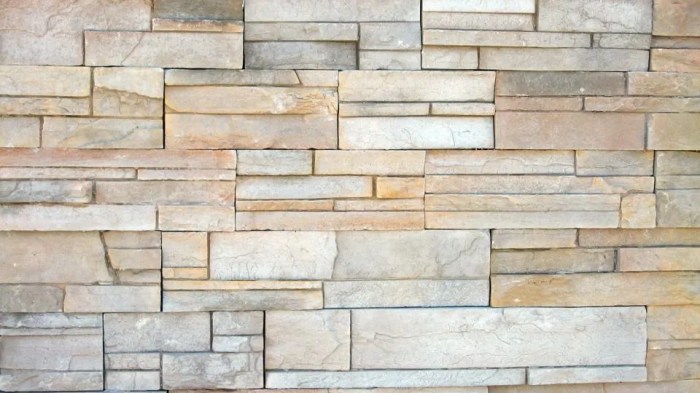
Stone veneer siding offers a visually appealing and durable exterior, but its overall value hinges on a careful consideration of both cost and environmental impact. Understanding the financial investment and the long-term sustainability implications is crucial for homeowners and builders alike. This section will dissect the cost-benefit analysis and explore the eco-friendly aspects of this popular cladding option.
The initial investment in stone veneer siding can be substantial, varying significantly based on several key factors. Material selection, labor costs, and project scope all contribute to the final price tag. However, comparing it to other siding materials reveals a more nuanced picture of its long-term value proposition. This comparison takes into account not only upfront costs but also the lifespan and maintenance requirements of each option.
Cost Comparison with Other Siding Materials
A comprehensive cost analysis requires examining various factors, including material costs, labor expenses, and the expected lifespan of the siding. While the upfront cost of stone veneer might be higher than vinyl or fiber cement, its longevity often translates to lower long-term maintenance costs. Let’s compare the approximate costs per square foot for different siding materials in a hypothetical mid-range project:
| Siding Material | Material Cost ($/sq ft) | Labor Cost ($/sq ft) | Total Cost ($/sq ft) | Estimated Lifespan (years) |
|---|---|---|---|---|
| Stone Veneer | $10-$25 | $10-$15 | $20-$40 | 50+ |
| Vinyl Siding | $2-$5 | $5-$8 | $7-$13 | 20-30 |
| Fiber Cement Siding | $4-$10 | $8-$12 | $12-$22 | 30-50 |
| Wood Siding | $6-$15 | $8-$15 | $14-$30 | 20-40 (with maintenance) |
Note: These are estimates and can vary widely based on location, material quality, and labor rates. Always obtain multiple quotes from reputable contractors for accurate pricing.
Environmental Impact of Stone Veneer Siding
The environmental footprint of stone veneer siding is a complex issue. While natural stone is a durable, long-lasting material, its extraction and processing can have significant environmental consequences. Quarrying operations can lead to habitat disruption, soil erosion, and water pollution. Transportation of the materials also contributes to greenhouse gas emissions. Proper disposal at the end of the siding’s lifespan is also a factor to consider, although the material itself is largely inert and can be reused or recycled in some cases.
The environmental impact varies greatly depending on the type of stone, its origin, and the extraction methods employed. For instance, locally sourced stone minimizes transportation impacts, reducing the carbon footprint.
Sustainable Sourcing Options for Stone Veneer
Minimizing the environmental impact of stone veneer siding involves making conscious choices about sourcing. Opting for locally quarried stone reduces transportation emissions. Look for suppliers committed to sustainable practices, such as responsible land management and water conservation during extraction. Recycled or reclaimed stone is another excellent sustainable option, diverting material from landfills and reducing the demand for newly quarried stone.
Choosing stone with a lower embodied energy (the total energy consumed throughout the material’s lifecycle) is another key aspect of responsible sourcing. Several certifications and eco-labels can help consumers identify sustainably sourced materials.
Cost-Saving Strategies for Stone Veneer Siding
While stone veneer can be expensive, several strategies can help mitigate costs. Careful planning and design can reduce material waste. For instance, using smaller pieces of stone in less visible areas or incorporating other materials strategically can decrease the overall quantity needed. Negotiating with suppliers and contractors to secure competitive pricing is essential. Consider undertaking some aspects of the installation process yourself, if you possess the necessary skills, to reduce labor costs.
Finally, prioritizing efficiency during installation minimizes material waste and labor time, resulting in significant savings.
Design Considerations for Stone Veneer Siding
Choosing the right stone veneer siding can dramatically enhance a building’s curb appeal and overall value. The selection process involves careful consideration of color, texture, pattern, climate suitability, and architectural harmony. A well-informed decision ensures a visually stunning and durable exterior that stands the test of time.
Stone Veneer Color and Texture Impact on Aesthetics
The color and texture of stone veneer significantly influence the perceived mood and style of a building. Light-colored stones, such as creamy beige or off-white, create a sense of openness and brightness, often associated with a classic or traditional aesthetic. They reflect more sunlight, potentially reducing cooling costs in warmer climates. Darker stones, like charcoal gray or deep brown, project a more dramatic and modern feel, often used in contemporary designs.
Their ability to absorb more heat should be considered in warmer climates. Textures range from smooth and polished, conveying elegance and sophistication, to rough and rustic, suggesting a more rugged and natural appeal. The interplay of color and texture creates a unique visual identity for each building. For instance, a home clad in smooth, light gray stone might exude a sleek, minimalist vibe, while a structure featuring rough-hewn, dark brown stone could project a more rustic, farmhouse-style charm.
You also will receive the benefits of visiting Smart Home Hub today.
Examples of Stone Veneer Siding Patterns and Designs
Several patterns and designs can be achieved with stone veneer. A running bond pattern, where stones are laid horizontally in a staggered arrangement, creates a clean, linear look that is both versatile and timeless. This is a popular choice for various architectural styles. A stacked bond pattern, featuring stones placed vertically on top of each other, provides a more modern and contemporary feel.
This pattern can add vertical emphasis to a building’s façade. A combination of different stone sizes and shapes, known as a random ashlar pattern, creates a more natural and organic look, reminiscent of traditional stonework. This approach can offer a highly textured and visually interesting finish. As an example, imagine a building with a stacked bond pattern using large, rectangular stones in a light beige color, contrasted by smaller, darker stones strategically placed to create visual interest.
This approach creates a visually appealing contrast that enhances the overall design.
Stone Veneer Selection for Different Climates, Stone Veneer Siding
Climate plays a crucial role in selecting the appropriate stone veneer. In regions with harsh winters and frequent freeze-thaw cycles, a durable and frost-resistant stone is essential to prevent damage. Porous stones may be susceptible to water absorption, leading to cracking or spalling in freezing temperatures. In hotter climates, stones with higher thermal mass and lighter colors can help regulate interior temperatures and reduce energy consumption.
Conversely, in areas with high humidity, a well-drained stone is crucial to prevent moisture buildup and the potential for mold growth. For instance, granite, known for its strength and durability, is suitable for colder climates, while limestone, with its natural porosity, might be a better choice in drier climates. Careful consideration of these factors ensures the longevity and performance of the stone veneer.
Stone Veneer Selection for Different Architectural Styles
The choice of stone veneer should complement the architectural style of the building. For traditional homes, a natural stone veneer with a rustic or classic appearance might be appropriate. This could include stones with a range of earthy tones and textures, such as fieldstone or flagstone. For contemporary homes, a sleek, modern stone veneer with a clean, geometric pattern might be preferred.
This could include stones with a smooth surface and a consistent color, such as quartzite or slate. For craftsman-style homes, a stone veneer with a handcrafted or rustic appearance would be a fitting choice. The use of varied stone sizes and shapes could create a sense of texture and visual interest, complementing the style’s inherent details. Selecting a stone veneer that aligns with the architectural style ensures a cohesive and aesthetically pleasing outcome.
Stone Veneer Siding vs. Other Exterior Cladding Options
Choosing the right exterior cladding can significantly impact a home’s curb appeal, durability, and overall value. This section compares stone veneer siding with popular alternatives like brick, vinyl, and fiber cement, highlighting their respective strengths and weaknesses to aid in informed decision-making for your next project. We’ll delve into factors such as longevity, maintenance needs, initial cost, and the unique aesthetic each material brings to the table.
Comparative Analysis of Exterior Cladding Materials
The following table provides a direct comparison of stone veneer, brick, vinyl, and fiber cement siding across key performance indicators. Understanding these differences is crucial for selecting the best option for your specific needs and budget.
| Feature | Stone Veneer | Brick | Vinyl | Fiber Cement |
|---|---|---|---|---|
| Durability | High; resistant to damage, but susceptible to cracking if improperly installed. | Very high; exceptionally durable and long-lasting. | Moderate; prone to dents, scratches, and fading over time. | High; resistant to rot, insects, and fire. |
| Maintenance | Low; occasional cleaning is usually sufficient. | Low; requires minimal maintenance, but mortar may need occasional repair. | Low; easy to clean, but may require occasional repairs. | Low; requires occasional cleaning and repainting. |
| Cost | Medium-High; more expensive than vinyl, but less than brick. | High; typically the most expensive option. | Low; generally the most affordable option. | Medium; more expensive than vinyl, but less than brick or stone veneer. |
| Aesthetic Appeal | High; offers a natural, rustic look that enhances curb appeal. | High; classic and timeless appearance; provides a sense of permanence. | Moderate; offers a wide variety of colors and styles, but can look artificial. | High; can mimic the look of wood or stone, offering versatility. |
| Suitable Projects | High-end residential homes, commercial buildings seeking a natural look; renovations aiming for increased property value. | High-end residential homes, commercial buildings requiring exceptional durability; historical renovations. | Budget-friendly homes, rental properties; projects prioritizing affordability. | Mid-range to high-end residential homes; projects requiring durability and low maintenance. |
Pros and Cons of Each Cladding Material
Each material offers unique advantages and disadvantages. Carefully weighing these factors is vital for making an informed decision. For instance, while brick offers unparalleled durability, its high cost might be prohibitive for some projects. Conversely, vinyl’s affordability comes at the cost of reduced longevity and aesthetic appeal compared to natural materials like stone.
Project Examples
Consider a high-end craftsman-style home in a rural setting. Stone veneer siding would perfectly complement the architecture and the surrounding landscape, creating a cohesive and visually appealing exterior. In contrast, a modern, minimalist home in a suburban neighborhood might benefit from the clean lines and low maintenance of fiber cement siding. A budget-conscious builder constructing a row of rental units might opt for vinyl siding due to its affordability and ease of installation.
Finally, a historical building undergoing renovation might necessitate the use of brick to maintain its original character and architectural integrity.
Last Recap
Stone veneer siding offers a unique blend of durability, aesthetic appeal, and potential cost-effectiveness. While initial investment may be higher than some alternatives, the longevity and enhanced curb appeal often justify the expense. By carefully considering factors like stone type, installation techniques, and long-term maintenance, you can unlock the full potential of stone veneer siding, transforming your building into a statement of enduring style and quality.
Remember, thorough planning and execution are key to a successful project, ensuring your investment yields a beautiful and lasting result.
